Must-Have Hotel Website Features
by Alyssa Foriska
The hospitality industry is a dense and competitive market where your hotel will have to stand up to some pretty stiff competition. In today’s digital world, it has become essential to not only embrace online tools, but utilize them to their full potential. As the digital face of your brand, your hotel website can act as an ally or foe, making or breaking your bottom line. Ensuring that your website is taking advantage of essential elements is one step to help your hotel maximize its online presence. Here is our list of must-have hotel website features:
What are the features of a hotel website?
- Security
- Compliance
- Responsive Design
- Clear & Concise Calls to Action
- Contact Information
- Hotel Information
- High-Quality & Recent Photography
- Speed
- Optimization
- Tracking & Analytics
- Additional Content
- Social Proof
- Reviews
- Data Collection
- Flexible Headless CMS
- Third Party Integrations

Security
As one of your top revenue-drivers, security for your hotel website should be at the top of your list. Keep hackers and cyber thieves at bay with a secure environment from start to finish. A few key things you can do to ensure your hotel website won’t be exploited for vulnerabilities include purchasing an SSL, updating your software regularly, choosing a reliable hosting company and pulling frequent backups.
Additionally, you can load your site behind a content delivery network, or CDN, for an added layer of protections against bots, choose secure passwords and try to limit third party scripts and add-ons when possible.
ADA Compliance
ADA compliance, short for the Americans with Disabilities Act Standards for Accessible Design means that all electronic information and technology must be accessible to those with disabilities. Establishing an accessible website for all is important not only for inclusivity, but for preventing costly litigation.
In an effort to make your website more accessible, the Web Content Accessibility Guidelines (WCAG) suggest making the following improvements to your website:
- Add descriptions, or transcripts for pre-recorded video and audio content
- Add descriptive ALT text to images so that they can be read by screen readers
- Ensure enough contrast between text and its background color
- Ensure that link anchor text is intuitive
- Add meaningful page titles that accurately portray the content.
- And more
Learn more about how you can become ADA compliant.
Responsive Design
When you consider the number of device types, device sizes and device brands, designing a hotel website that performs universally is crucial to success. At TravelBoom, we’ve seen consistent growth in mobile traffic and revenue. A responsive hotel website allows guests to easily browse content from desktop to tablet and beyond.
Learn more about the who, what, when, why and how of hotel website redesign.
Clear & Concise Calls to Action
Driving traffic to your hotel website might be a challenge, but converting visitors into guests can sometimes feel impossible. Whether your goal is to earn a booking or generate a lead, make sure your calls to action are clear to the user.
- Use large buttons that stand out and can be easily clicked on mobile.
- Use contrasting colors so that CTAs are easily noticeable.
- Reduce the number of required form fields to simplify submission for a user.
- Use strong command verbs and invoke a sense of urgency where necessary.
- Test your CTAs on all device types.
Contact Information
Adding contact information to your hotel website provides your potential guests with an easy way to connect with you. A hotel stay can be a large expense and visitors often have questions prior to booking their stay. Including a real phone number, email address and contact form can help to eliminate some friction during the decision making process.
Contact information should be especially accessible for mobile users. Ensure that telephone numbers are click-to-call, addresses open in maps and email addresses open a new message.
Hotel Information
Beyond the basics of our must-have hotel website design elements, showcasing what your property has to offer is a no-brainer. Be as thorough as possible when highlighting what sets your hotel apart, but keep in mind that too much information can become overwhelming.
- What amenities do you offer? Are they included with each stay?
- Do you offer any special deals or packages?
- Does your property have meeting or wedding space?
- Is there on-site dining at your hotel?
- Does your property have a pool or fitness center?
Some guests may be looking for casual comforts while others may be looking for more extravagant on-site options. Make sure your amenities are presented in a way that entices both types of customers.
Additionally, an FAQ page can be advantageous in answering common questions that arise surrounding your hotel’s most important information.

High-Quality & Recent Photography
We’ve all heard the phrase “a picture is worth a thousand words,” and this mantra rings especially true within the hospitality space.
Showcasing visually stunning photography can make a striking first impression on potential guests, or be the deciding factor for their stay. Investing in professional hotel photography (and videography) can set your hotel apart from the competition.
Speed
Nowadays, a slow website won’t only negatively impact your conversion rate, but your overall rankings in the SERPs, as well. While Google’s Page Experience signals encompass many of the hotel website elements within this list, we know that a large weight is placed on site speed.
Two elements in particular are centered around a fast, frictionless user experience. Philip Walton defines them as:
- Largest Contentful Paint (LCP) is an important, user-centric metric for measuring perceived load speed because it marks the point in the page load timeline when the page’s main content has likely loaded—a fast LCP helps reassure the user that the page is useful.
- First Input Delay (FID) is an important, user-centric metric for measuring load responsiveness because it quantifies the experience users feel when trying to interact with unresponsive pages—a low FID helps ensure that the page is usable.
There are a variety of tools to help measure your hotel website’s Core Web Vitals. PageSpeed Insights, for example, is a free online tool that will deliver a report in real-time that includes specific action items necessary to achieve a passing score.
Optimization
In-depth website optimization has become crucial for online success. Optimizing a website for search can be a complex, time-consuming process. The term ‘optimization’ can encompass a variety of disciplines, including both on-page SEO and technical SEO (when considering a hotel’s website). Some key hotel website elements that would fall within optimization might include:
- Content optimizations including but not limited to on-page headers and links.
- Metadata optimizations including title tags and meta descriptions.
- The addition of structured data, or schema markup.
- Ongoing health check-ups for 404 errors, broken links and more.
- Site speed optimization as mentioned above.
Check out our Ultimate SEO Audit for Hotels to learn more about how you can optimize your hotel website.
Tracking & Analytics
Maintaining visibility into your data plays an integral role in making informed marketing decisions. Tracking, and the data that it can provide, is arguably one of the most important elements or features of a hotel website.
Setting your site up for success by implementing both universal tracking and e-commerce tracking allows hoteliers to glean insights from both channel and user behavior data. Google Analytics is a free and powerful tool that not only shows you how well your website is performing, but also where it might be failing.
If you’re unsure of how to get started, the analytics experts at TravelBoom can help.
Additional Content
Offering website visitors more information than what your hotel has to offer can set you up as an authority in the eyes of both the user and the search engine. Content in the form of an area guide or blog can improve rankings, increase qualified traffic and best of all – help vacationers plan their stay.
Including additional content on your hotel website positions you as an expert source for area information and allows you to target long-tail keywords that your site may not have otherwise ranked for. Check out our guide to creating kick-ass blog content for your hotel website to learn more.
Social Proof
Social Media
Connecting with guests through social media has proven valuable in more ways than one. Fostering a community of followers is one of the best ways to engage previous guests and turn fans into visitors. Highlighting this social proof should be a key element of any hotel website. A few ways to incorporate this might be:
- Display links to your social profiles on your hotel website.
- Embed a real-time social media feed on-page.
- Feature on-page user generated content (UGC) through third party services.
Reviews
Like social media, reviews instill confidence in potential guests during the research phase of booking a vacation.

Data Collection
This simple, yet effective, website feature can pack a big punch. Data collection can happen in the form of a sign-up form, a lead form or a booking. Once you build a database, the possibilities are endless. Below are a few ways you can maintain communication with past or potential guests:
- Hotel email marketing
- Targeted ad placement
- Remarketing
- Personalization
- Direct Mail
Flexible Headless CMS
An up-and-coming must-have element for your hotel website is a headless CMS, an admin panel that is decoupled from the front end of a website and offers a content-first approach that utilizes an API to access and display content. Designed to render as quickly as possible, headless websites decouple your database from what a customer sees, and relies on multiple servers instead of one.
There are several advantages to going headless, including:
- Increased performance and faster load times.
- Reduced code conflicts and website issues.
- Flexibility in programming language.
- A scalable option for future needs.
- Security improvements.
- Increased uptime.
Alternatively, you may forfeit some flexibility and there is a learning curve. However, the pros outweigh the cons when considering must-have features for your hotel website.
Bonus: Third Party Integrations
By no means are third party integrations necessary to power a website, however there are a few honorable mentions that support many of the must-have website features noted in our list.
- Social Proof: CrowdRiff; Flip.to
- Compliance: UserWay, accessiBe
- Tracking: Google Analytics
- Data Collection: Gravity Forms
- Live Chat: Navis; Olark
Is your site missing most of these must-have hotel website features? TravelBoom can help. Contact us today for a free evaluation.